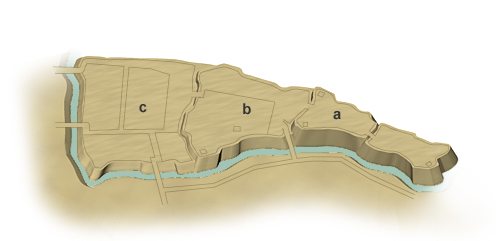|
||
 |
||

a)
*honmaru 本丸 b)
*ni-no-maru 二の丸 c) san-no-maru 三の丸
(C)2001 Japanese Architecture and Art Net Users System. No reproduction or republication without written permission.
掲載のテキスト・写真・イラストなど、全てのコンテンツの無断複製・転載を禁じます。
|
||||||
| nawabari 縄張 | ||||||
| KEY WORD : architecture / castles | ||||||
| Castle plan; general term for the layout of a castle and its component structures. Lit. stretched rope, the term is said to derive from the fact that originally a rope was stretched between stakes, positioned at intervals, to determine the placement of the castle compound and components. Before the 17c precise drawings were not made; a general plan of a castle and its surroundings were made directly, according to the lay of the land. Fundamental to the plan is the placement of the enclosures *kuruwa 郭, moats *hori 堀, earth and stone ramparts *doi 土居 and sekirui 石塁, entrances *koguchi 虎口 and roads. Castles are classified into single-compound and multi-compound structures. Multiple-compound castles were constructed in a number of different layouts, including concentric circles, concentric squares, plans with compounds aligned along an axis or those with whirlpool layouts or star-shaped plans. They are called *teikakushiki 梯郭式, renketsushiki 連結式, goryoukakushiki 五稜郭式. Plans are also conceived in terms of the basic function of the castles: some are primarily defensive, whilst others are offensive installations. Early modern Japanese military scholars, using the principles of Chinese yin and yan thought, termed defensive castle plans in-no-nawa 陰の縄, and offensive castles plans you-no-nawa. 陽の縄. Similar terminology was applied to component castle structures. | ||||||

a)
*honmaru 本丸 b)
*ni-no-maru 二の丸 c) san-no-maru 三の丸
|
||||||
| REFERENCES: | ||||||
| *in'you-no-kuruwa 陰陽の郭 | ||||||
| EXTERNAL LINKS: | ||||||
| NOTES: | ||||||
(C)2001 Japanese Architecture and Art Net Users System. No reproduction or republication without written permission. 掲載のテキスト・写真・イラストなど、全てのコンテンツの無断複製・転載を禁じます。 |
||||||